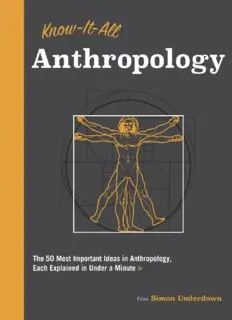
Know It All Anthropology: The 50 Most Important Ideas in Anthropology, Each Explained in Under a Minute PDF
Preview Know It All Anthropology: The 50 Most Important Ideas in Anthropology, Each Explained in Under a Minute
Know It All ANTHROPOLOGY The 50 Most Important Ideas in Anthropology, Each Explained in Under a Minute > Editor Simon Underdown Contributors Russell Adams Sue Black Brad K. Blitz Jason Danely Ken Dark Jan Freedman Charlotte Houldcroft Marta Mirazón Lahr Michael Bang Petersen Joshua Pollard David Shankland Simon Underdown Djuke Veldhuis CONTENTS Introduction Evolution GLOSSARY The Hominins Brain Development Tools Fire The Neanderthals Homo sapiens Profile: Richard Leakey Ancient DNA The Human Species GLOSSARY Race Variation Dispersal & Distribution Profile: Margaret Mead Is Anyone Indigenous? Africa Asia Europe The Americas Australasia Materials GLOSSARY Clay Profile: Franz Boas Bronze Age Metallurgy Industry & Mining Craft Discoveries Socialization & Communication GLOSSARY Domestication Settlement Profile: Bronislaw Malinowski Linguistics Language Symbols Ritual & Ceremony Death Art & Artifact Why Do We Care? Migration GLOSSARY Navigation Trade Profile: Clifford Geertz Borders Economic Migrants Refugees Ideas GLOSSARY Religion & Belief Identity Politics Profile: Claude Lévi-Strauss Hierarchy & Leadership Kinship Dunbar’s Number Gender Modern Peoples GLOSSARY Ethnicity War & Aggression Artificial Intelligence Ethics Genetic Engineering Profile: Paul Farmer The Human Age Globalization Forensic Anthropology Appendices Resources Notes on Contributors Index Acknowledgments INTRODUCTION Simon Underdown Anthropology is the study of the most complex and contradictory species on the planet—us. Humans are not easy to understand and are even more difficult to explain. On paper, we are a relatively large, naked form of ape with a big brain and an odd way of walking on two legs. Yet we have taken our ability to use culture, such as tools, to solve biological problems and conquered the world. Around 2 million years ago our ancestors started to look and behave in a recognizably human way. From then on, our ability to shape the environment intensified to the level we find ourselves at today. This book is an instruction manual for human beings. It will help you understand how we evolved from a chimplike ancestor to being able to send rockets to Mars. Humans are unquestionably special and occupy a unique place in the history of the planet. Our brains are the most complex thing in the known universe and nothing approaches the intricacy and sophistication of human thought. But when we compare our behavior to that of other primates, the gulf is perhaps not as great as we might like to think. Chimps and many other species of primates use tools and display highly advanced levels of intelligence. Yet the gap in ability and achievement remains insurmountable. Humans today can be found on every continent, and, alongside our technology, we have developed a bewilderingly large range of religions, beliefs, and cultural practices. No other species comes close to being as odd as us. This is what anthropology tries to explain, and it is, perhaps, one of the most difficult questions in science. We share 98 percent of our DNA with chimpanzees, but our genetic similarity is offset by the gulf in intelligence and culture between us and our evolutionary cousins. What’s in a Name? Anthropology is broadly split into two subdisciplines: social anthropology and biological anthropology. Social anthropology explores societies and cultures in all their diversity and is a largely self-sufficient subject that draws on its own methods. Biological anthropology blurs the lines between traditional academic subjects, and it uses methods from areas as diverse as genetics, physics, and archaeology to explain human beings within the context of evolution— especially how our biology interacts with our culture. Traditionally, anthropology is not a subject with good PR and outside of universities it is not well known or well understood. Anthropology still conjures up images of men in pith helmets somewhere “exotic.” But despite this misapprehension, anthropology is “done” by a wide range of people, both at home and abroad, who may not use the label but are still “doing” anthropology. Historically, the fifth-century BCE Greek historian Herodotus was perhaps the first anthropologist and his, albeit sometimes fictional, accounts of foreign cultures and behaviors has a distinctly anthropological theme. The roots of the subject as an academic discipline belong to the nineteenth century, when ethnographers began to study people in the expanding European empires—often as means of reinforcing ideas of European supremacy. In the twentieth and twenty-first centuries, a backlash against such outmoded thinking has created a context in which today human variation is championed and our shared evolutionary heritage is celebrated. Herodotus wrote about the known world in a distinctly anthropological way—identifying variation and reflecting on shared traits. How This Book Works This book presents 50 of the most important ideas and concepts in twenty-first- century anthropology. Each section has three parts: the main entry describes a key anthropological concept in detail, the 3-minute descent places the idea in the wider context of being human, and the 3-second origin provides the essence of the idea in a single sentence.
